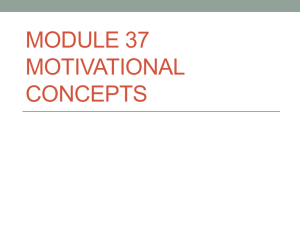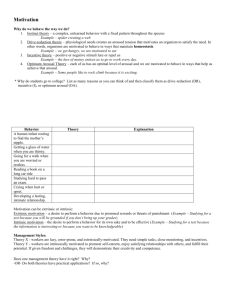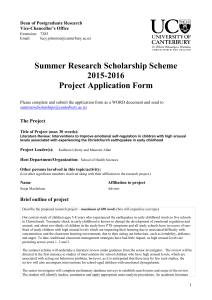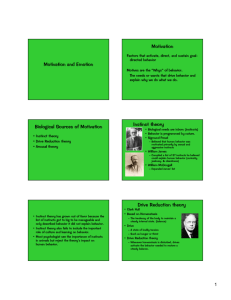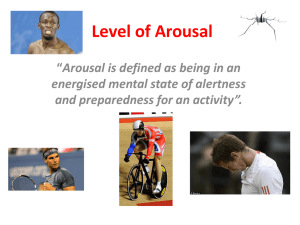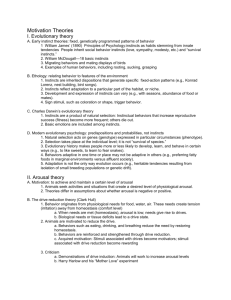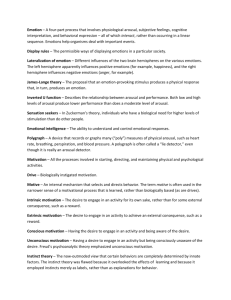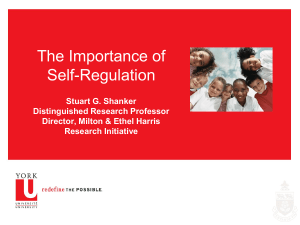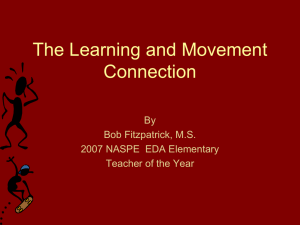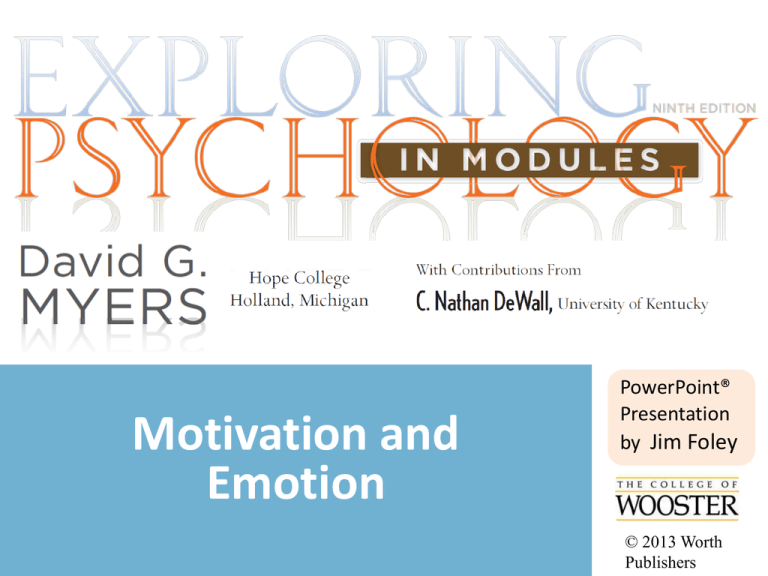
Motivation and
Emotion
PowerPoint®
Presentation
by Jim Foley
© 2013 Worth
Publishers
Module 28: Basic Motivational Concepts,
the Need to Belong, and Achievement
Motivation
Topics you might be driven
to learn about
Models of Motivation:
Instincts and
Evolutionary
Psychology
Drives and Incentives
Seeking Optimum
Arousal levels
A Hierarchy of
Motives
The Need to Belong
The Pain of Being
Shut out
Social Networking
The Motivation to
Achieve, to Work
Motivation
Motivation: a need or
desire that energizes
behavior and directs it
towards a goal.
For example, Aron Ralston
found the motivation to cut off
his own arm when trapped on a
cliff in Utah in 2003.
What motivated him to do this?
Hunger? The drive to survive?
The drive to reproduce?
Perspectives on Motivation
Instinct Theory
Evolutionary
Perspective
Hierarchy of
Needs/Motives
There are different
ways of thinking of
the way motivation
works, all of which
relate to the
“push” of biological
processes and the
“pull” of culture,
social forces, and
ideals.
Arousal
[Optimization]
Theory
DriveReduction
Theory
Do Instincts Direct Human Behavior?
An instinct is a fixed (rigid and predictable) pattern of
behavior that is not acquired by learning and is likely to
be rooted in genes and the body.
Human
“nesting”
behavior
Instinctual
nesting
Instincts Evolutionary Perspective
Other species have genetically
programmed instincts “motivating”
their actions.
Do humans?
Human babies show certain
reflexes, but in general, our
behavior is less prescribed by
genetics than other animals.
We may, however, have general
patterns of behavior which can be
explained as emerging through
natural selection.
Instinct theory has given way to
evolutionary theory in explaining
human behavior.
Drive Reduction
A drive is an aroused/tense state related to a physical
need such as hunger or thirst.
Drive-reduction theory refers to the idea that humans
are motivated to reduce these drives, such as eating to
reduce the feeling of hunger. This restores homeostasis,
a steady internal state.
Seeking Optimum Arousal
Some behavior seems
driven by a need to
either increase or
decrease our
physiological arousal
level.
Curiosity, as with kids
and these monkeys,
may seek stimulation
to reach an optimum
arousal level.
A hunger for
stimulation, novelty,
makes humans
infovores, seekers of
knowledge.
Performance and Arousal Level
What happen when we succeed at raising our
arousal levels?
Yerkes-Dodson Law:
Arousal levels can
help performance
but too much
arousal can
interfere with
performance.
For taking an exam,
moderate arousal
might be best.
Below: the effect of arousal on
performance depends on how
comfortable we are with the task.
Hierarchy of
Needs/Motives
Abraham Maslow
proposed that
humans strive to
ensure that basic
needs are
satisfied; then,
they find
motivation to
pursue goals that
are higher on this
hierarchy.
Violating the
Hierarchy?
Do hunger strikers
and mystics feel
secure enough in
meeting their needs
that they can do
without food
temporarily to pursue
a higher goal?
Soldiers sacrifice safety, but
could they be seen as fighting
for safety, both indirectly
(protecting the country) and
directly (defeating the people
shooting at them)?
Another Motivation: “To Belong”
What do people need
besides food and sex?
Aristotle: social life
Alfred Adler: community
In Middle English, to be
wretched [wrecche]
means to “be without kin
nearby”
Roy Baumeister, Mark
Leary, and Abraham
Maslow say we need:
“To Belong.”
Belonging: being connected
to others, part of a group or
family or community.
Why do we
have a need to
belong?
Emotional
support to
get through
crises
Keeping
children
close to
caregivers
Evolutionary
psychology
perspective:
seeking bonds with
others aids survival
in many ways
Division of
labor to
allow
growing
food
Mutual
protection
in a group
Cooperation in
hunting and
sharing food
Balancing Bonding with Other Needs
The need to bond with others
is so strong that we can feel
lost without close
relationships.
However, we also seem to
need autonomy and a sense
of personal
competence/efficacy.
There a tension between “me”
and “us,” but these goals can
work together.
Belonging builds self-esteem,
and prepares us for confident
autonomy.
The Need to Belong Leads to:
loyalty to friends,
teams, groups, and
families.
However, the need to
belong also leads to:
changing our
appearance to win
acceptance.
staying in abusive
relationships.
joining gangs,
nationalist groups,
and violent
organizations.
Disrupted Bonds, New Beginnings
Children repeatedly moved
away from primary
caretakers in childhood
may have difficulty
forming deep attachments
in adulthood.
People losing a loved one
or moving away from a
hometown can feel grief.
Being ostracized, cut off
from social contact or
excluded, can lead to real
physical pain.
And yet people can find
resilience and relief from
pain by building social
connections.
Social Networking =
Social Connection?
Is our online selfdisclosure honest, and
healthy?
Is social networking making
us more connected, or less?
Do updates and tweets build
connection?
Use of social networking can
become a compulsion, sacrificing
face-to-face interaction and indepth conversation.
Research shows: Portrayal of
one’s self online is often close to
one’s actual sense of self.
Research shows: Online social
networking is associated with
Narcissism/self-centeredness
less connection to neighbors
more connection to people
who share our narrow
interests and viewpoints
Motivation to excel in work
What is our motivation to do
well in our jobs?
Is it just the desire for
belonging, and gaining
income to meet basic needs?
Humans in many cultures
seem to have an
achievement motivation, a
desire for:
accomplishment of goals,
mastery of skills,
meeting of standards,
control of resources.
What helps us satisfy our
achievement motivation?
• Discipline: Sticking to a
task despite distractions
• 10-year rule: Having
enough experience to
Develop expertise in a field
• Grit: passionate
persistence at a goal
• Hardiness: Resilience
under stress

